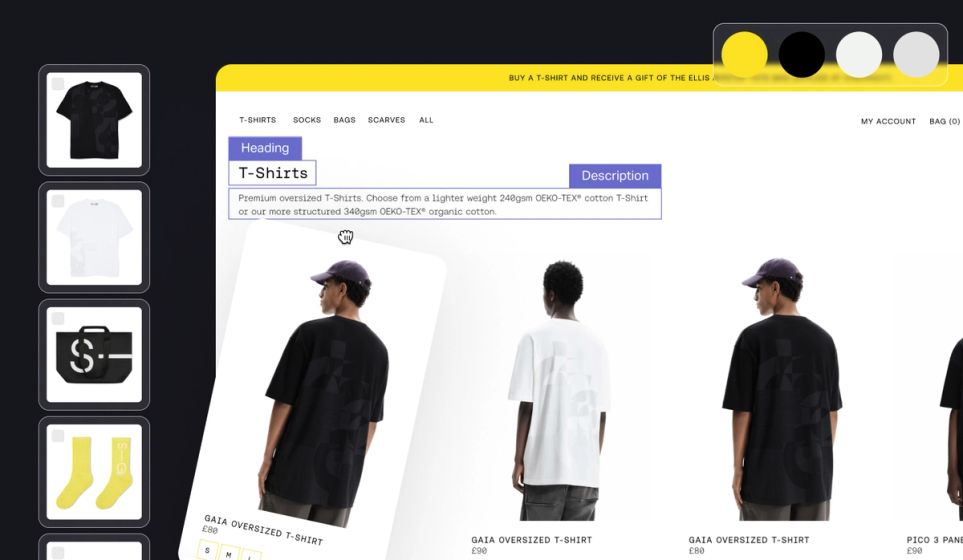
Shopify and BigCommerce both promise scalability and performance, but how do they actually compare? We explore key differences in user experience, pricing, flexibility and growth potential to help you make the right call.
Choosing the best platform for your business
Your e-commerce platform does more than process transactions—it shapes how you scale, how efficiently you operate and how easily you grow. Choose well, and you get speed, stability and flexibility. Choose poorly, and you could face mounting development costs and roadblocks that slow you down.
Shopify and BigCommerce are two of the biggest names in e-commerce, but they cater to slightly different needs. One is known for its polished, plug-and-play experience. The other builds more native functionality into its core product, often appealing to merchants who want more built-in power without relying on apps.
So, which is right for your business? Let's break it down.
Shopify vs BigCommerce: Which platform is more user-friendly?
Shopify is built for businesses that want to launch quickly—36% faster than BigCommerce on average—and manage their store without hiring a development team. The drag-and-drop store builder, pre-designed themes and intuitive admin panel make it accessible to merchants of all sizes. Features like automated updates, built-in hosting and 24/7 customer support mean that technical maintenance is handled for you, allowing businesses to focus on growth.
Shopify’s ecosystem also includes an expanding range of AI-powered tools, such as Shopify Magic, which helps merchants generate product descriptions and automate workflows.
BigCommerce is also a hosted platform with an intuitive dashboard, but it leans slightly more technical. Its feature-rich interface gives you more control but at the cost of a steeper learning curve. There are more options built into the platform by default, which is powerful—but can also be overwhelming for new users or those without technical expertise.
For most businesses, Shopify’s user-friendly interface makes store management easier and faster while still offering flexibility when needed.
Shopify vs BigCommerce: Scalability and performance
Setbacks make all the difference when growth is the goal.
Shopify provides enterprise-grade scalability without merchants having to worry about infrastructure management. Shopify Plus, the platform’s enterprise solution, is designed to handle high-volume transactions, peak traffic spikes and global multi-store operations. Shopify’s 99.98% uptime, globally distributed CDN and automatic server scaling ensure that brands can continue growing without infrastructure bottlenecks. Businesses like Allbirds and Gymshark have leveraged Shopify to scale rapidly while maintaining sub-two-second page load speeds, which is crucial for conversion rates.
BigCommerce also scales effectively and is built on Google Cloud infrastructure. Its native multi-storefront functionality, strong API capabilities and support for internationalisation make it a strong contender for businesses looking to grow. However, it may require more manual configuration to match Shopify's automation and load optimisation.
For brands prioritising long-term growth without added complexity, Shopify offers a scalable infrastructure that eliminates the risks associated with performance bottlenecks.
Shopify vs BigCommerce: Customisation & flexibility
Do you need ultimate control?
BigCommerce provides advanced built-in functionality out of the box—from faceted search to flexible discounting logic and user roles. For businesses with specific operational requirements, these built-ins reduce reliance on third-party apps and simplify complex configurations. However, to get the most out of the platform, brands will still need developer support, especially when working with BigCommerce’s headless framework or APIs.
For example, a B2B retailer looking to support complex pricing structures or customer-specific catalogues may benefit from BigCommerce's robust native functionality. However, building these workflows still requires technical input, especially if you want to integrate external systems or build custom checkout logic.
Shopify takes a structured approach to flexibility. Through Liquid templating and Shopify Functions, brands can customise their store’s front-end and business logic without modifying the platform’s core. Shopify’s headless commerce capabilities allow businesses to create unique storefronts while benefiting from Shopify’s security and scalability.
For most businesses, Shopify offers all the flexibility needed without the overhead of managing server-side code or complex integrations. Brands that require deeply tailored backend functionality may lean toward BigCommerce, but Shopify provides a strong middle ground for brands that want to move fast.
Shopify vs BigCommerce: pricing
Because hidden costs can make 'free' more expensive.
BigCommerce offers plans starting from $39/month and does not charge additional transaction fees when using third-party payment gateways. This can make it an attractive option for merchants who don’t want to be locked into a proprietary payment system.
However, BigCommerce enforces revenue-based plan upgrades—automatically moving merchants to higher-tier plans once they exceed $50k/year for Standard and $180k/year for Plus—which can lead to unpredictable costs for fast-growing brands.
Shopify follows a predictable pricing model. Standard plans range from $29 to $299 per month, with Shopify Plus starting at $2k+ per month. While Shopify charges transaction fees if you don’t use Shopify Payments, its flat-tier pricing and growing built-in toolset keep overall costs transparent and manageable.
For growing businesses that need cost predictability, Shopify provides a lower total cost of ownership in the long run, with up to 32% lower platform costs reported compared to BigCommerce.
Shopify vs BigCommerce: Which has better apps and plugins?
The right tools give your store a competitive edge.
Shopify provides access to over 12,000 apps that extend store functionality. The Shopify App Store is carefully curated, ensuring that third-party solutions meet high standards for security, usability and effectiveness. These apps cover everything from advanced SEO optimisation and AI-driven customer engagement to subscription management and logistics automation. Shopify also natively integrates with Meta, Google, TikTok, Amazon and Klaviyo, making omnichannel selling seamless and scalable.
BigCommerce offers a smaller app marketplace, with around 1,200 apps. Many core integrations are supported, including Mailchimp, Google Shopping and Meta, but the ecosystem is less mature than Shopify’s. You may need to work more closely with developers or third-party providers to achieve similar outcomes.
Shopify’s extensive app ecosystem and native integrations give it the edge for businesses that want to scale quickly without relying on custom-built solutions.
Shopify vs BigCommerce: Global selling and shipping
It shouldn’t be complicated.
Shopify simplifies logistics with Shopify Shipping, which offers discounted carrier rates, real-time tracking and seamless label printing. Its multi-location inventory system allows merchants to track stock across warehouses and stores, reducing overselling and fulfilment delays. For international selling, Shopify Markets enables brands to manage currency conversions, taxes and region-specific checkout experiences, making cross-border commerce straightforward.
BigCommerce also supports multi-currency, international domains and regional settings. Its multi-storefront architecture enables regional targeting and B2B setups from one account. However, configuring these options typically requires more setup time and greater technical input.
Compared to Shopify’s built-in global selling capabilities, BigCommerce demands more oversight to manage international operations effectively.
Shopify vs BigCommerce: Marketing features
Which platform turns more clicks into customers?
Shopify includes built-in SEO tools, automated email marketing integrations and seamless connections to advertising platforms like Google Ads and TikTok. Shopify’s marketing ecosystem allows brands to launch targeted campaigns, track customer behaviour and optimise conversions with minimal technical setup.
Shopify stores achieve a 12% higher conversion rate on average compared to BigCommerce.
A strong example of Shopify’s marketing power is its abandoned cart recovery feature. Klaviyo’s dataset on abandoned cart emails reports an average open rate of 41.18%, a 9.50% click rate, and a revenue per recipient of $5.81, demonstrating the effectiveness of automated follow-ups in converting lost sales. By leveraging Shopify’s email automation and customer engagement tools, merchants can recapture revenue with minimal effort.
BigCommerce offers similar capabilities but relies more heavily on external marketing tools for email automation, analytics and CRM. While it integrates well with platforms like HubSpot and Google Tag Manager, merchants often need more configuration to get everything working in harmony.
Shopify provides a more integrated experience that makes it easier to launch, manage and optimise marketing efforts from day one.
Shopify vs Bigcommerce: Security
It should be effortless, but some platforms make you work for it.
Shopify provides fully managed security with PCI DSS Level 1 compliance, fraud detection tools and automatic security patches. Because Shopify hosts all stores on its own secure cloud infrastructure, merchants don’t have to worry about managing SSL certificates, applying security updates or protecting against DDoS attacks. Shopify’s fraud protection algorithms help merchants identify high-risk transactions, reducing the chances of chargebacks and payment fraud.
BigCommerce is also secure, but merchants are responsible for more aspects of security, including certain updates, third-party software patches and integration monitoring. While the platform meets PCI standards and supports SSL, the merchant retains more control—meaning more responsibility. Businesses that lack a dedicated IT or DevOps team may find these requirements challenging.
For merchants who want to trust that their platform has security covered without extra input, Shopify is the more streamlined and hands-off option.
Shopify vs BigCommerce: Which do experts recommend?
When it comes to expert recommendations, Shopify consistently ranks as the best choice for most businesses due to its ease of use, scalability, and comprehensive ecosystem.
Forbes Advisor notes that "Shopify is the best all-around e-commerce platform on the market today, offering a balance of usability, customization, and affordability that makes it ideal for businesses of all sizes." (Forbes)
TechRadar highlights Shopify’s user-friendliness and vast app ecosystem, stating that "Shopify’s intuitive design and extensive integrations make it a leading choice for merchants looking for a hassle-free way to launch and scale an online store." (TechRadar)
Conversely, PCMag notes that BigCommerce is "a powerful e-commerce platform with strong inventory options, many themes, and zero fees from third-party payment gateways." However, they also mention that it "lacks Shopify's integrated point-of-sale software and Wix Stores' dashboard simplicity." PCMAG+1PCMAG+1
Industry analyses suggest that while BigCommerce offers robust features suitable for businesses with specific needs, Shopify's ease of use and comprehensive ecosystem make it the preferred choice for a wide range of businesses seeking a scalable and user-friendly e-commerce solution.
Our opinion? Shopify all the way.
After years of working with brands at every stage of their e-commerce journey, we’ve seen firsthand the difference Shopify makes. It’s faster to launch, easier to manage and more cost-effective than BigCommerce—without sacrificing scalability or flexibility. Shopify empowers brands to focus on growth, not platform maintenance.

Thinking of migrating?
Shopify’s migration tools ensure that customer data, order history, product catalogues, SEO settings, and site structure are transferred accurately so businesses can switch platforms without disruption. Shopify’s automated solutions help preserve your store’s structure, including product variants, collections, and customer profiles, so nothing gets lost in the transition.
At Series Eight, we ensure a smooth transition by focusing on data integrity, storefront optimisation, and seamless integration with Shopify’s native tools and apps. Our expertise ensures your new store is not only functional from day one but also optimised for long-term growth. We replace previously custom-built features, eliminating unnecessary development and reducing long-term costs.
A successful migration isn’t just about moving data—it’s about ensuring your Shopify store is optimised for performance, usability and growth. We ensure that custom workflows, integrations and checkout experiences are translated effectively within Shopify’s framework.
We’ve seen first-hand how migrating from BigCommerce to Shopify can streamline operations, improve performance and reduce technical overhead. By replacing custom legacy workflows with Shopify-native tools and integrations, brands are able to simplify campaign management and reduce long-term development costs.
Our team ensures your Shopify store isn’t just a replica of your old BigCommerce site—it’s an upgrade. We optimise for better efficiency, improved user experience and long-term scalability, so you’re not just migrating—you’re future-proofing your business.
Ready to build a better online store?


